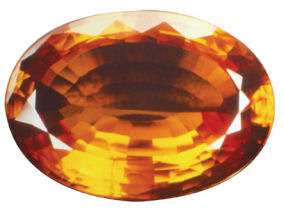Thai Treasures
March 01, 07
Gem mining is currently weak in Thailand compared to what it was a few years ago. However, some mines are still in production in Chanthaburi and Kanchanaburi - a tourist destination best known for its bridge over the river Kwai. With the decline of its gem mining industry, Thailand has transformed itself from the mining center it was in the 1960s and early-1970s to the world’s major manufacturing and production center for rubies and sapphires. Approximately 70 percent of the world’s sapphire output and 90 percent of its ruby production currently pass through Thailand at some stage on their way from the mines to the final customer. Along with Sri Lanka, Thailand currently provides the best heat-treatment technology available for ruby and sapphire. It is also a major cutting, jewelry making, and business-friendly export center. 
The Bo Ploy area, 30 kilometers north of Kanchanaburi is a shadow of its past. While the SAP company is still mining a large area there, it is converting most of the depleted mining land into a golf course and lake resort. The area was first discovered in 1918, but soon after, the deposit was thought to be depleted. Its rediscovery in 1987, turned the area into a major mining center, but, again, after few years of strong activity, production decreased and has almost stopped. Apart from blue sapphire, large quantities of black spinel known locally as “nin” are mined and most of the time, sold in the many Thai street markets as “onyx.”
The Chanthaburi area is probably the oldest Thai mining area. Discovered in the middle of the 19th century, it had strong ruby mining activity until the military took power in Burma in 1962, when the supply of Burmese rubies and sapphires ceased. Ruby mines near Bo Rai were the world’s major source of rubies for nearly 30 years until the arrival of the Mong Shu rubies from Myanmar, which hit the market in the early 1990s. This new addition to the market was a fatal blow for most ruby mining in Thailand and East Africa. In the Ban Kha Cha area southwest of the city, some small scale and larger scale mining activity is still visible. However, most of the production there is black star sapphire along with some less frequent blue, green, and yellow gems. East of Chanthaburi, around Bo Rai, the large mechanized ruby mines visible during the 1970s and 1980s are now only a distant memory. Several small scale mining operations and some individual river mines are still active in a few parts of this area.
In northern Thailand, near Phrae, which has always been known to produce small quantities of sapphire, renewed mechanized mining is being reported.
There have been reports of some small-scale sapphire mining in the eastern part of the country close to the Cambodia-Laos border, but this has not yet been verified.
Chanthaburi is also the main heat treatment and cutting center. The leadership of Bangkok companies is regularly challenged by Chanthaburi dealers and innovative burners. Chanthaburi even has a famous weekend gem market, which starts each Friday morning and goes on until Sunday. Currently, all types of fine rubies and sapphires can be found there - from the rare unheated stones to gems heated with or without fluxes, using beryllium technology, or the new lead glass treatment. Besides rubies and sapphires, fine tourmalines, garnets, beryls, spinels, and occasionally other gems can also be found. But Chanthaburi is also very busy during the week. Monday to Thursday rough dealers bring their gems to the city to supply the burners and the cutting factories.
Thailand has two other interesting markets that are becoming less active due to the gradual opening of Burma and the new importance of African countries, like Madagascar and Tanzania, as suppliers for the Thai gemstone industry. Mae Sot, a town on the western Thai-Myanmar border, traditionally dealt with Mogok gemstones and Hpakant jadeite. However, these days, visible market activity there is minor and most shops display low quality gems from diverse origins (Burmese or African) along with synthetics and imitations. Behind the scenes, Mae Sot dealers are still important players in the Thai gem trade with their links to the Mogok mining area. Some Mae Sot people formerly involved in the filling of ruby material from Mogok in the 1990s were also recently involved in the new lead glass treatment and possibly the star rubies recently seen at the AIGS Bangkok laboratory.
These stones contained some lead glass filling in cavities and fissures and may have passed through Mae Sot furnaces. Mae Sai, a town on the northern Thai-Myanmar border, was the main trading center for the Mong Shu rubies. The activity there is still important. Every weekend, stones can be seen in the gem market despite the invasion of street shops selling imitation and synthetic products along with low quality gems from diverse origins to tourists visiting the area. Several burners specialized in Mong Shu treatment using flux additives, are active in the area which is now, more than before, just a short stop for gems on their way to Chanthaburi.
In the Bankacha area, located 10 kilometers from Chanthaburi, at least three mechanized mining operations producing blue, green and yellow sapphires of large size and black star sapphires, are active.
Article reproduced courtesy of the International Colored Gemstone Association (ICA).